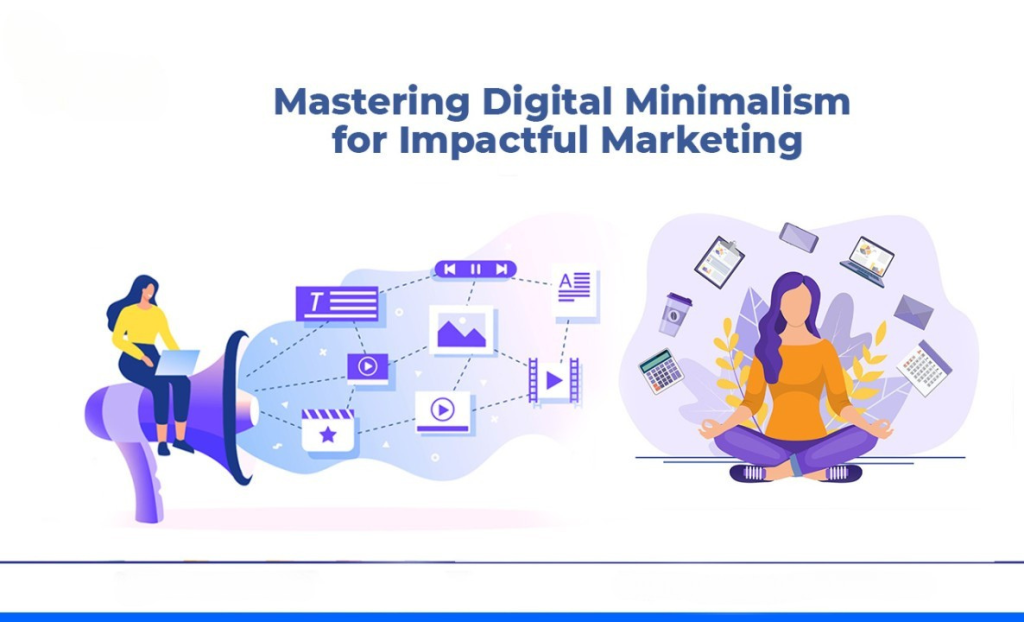Digital Minimalism: Why Less Content Could Mean More Impact.
Introduction
We live in a world where content is being produced faster than ever. Every second, thousands of blog posts, videos, tweets, and ads are published online. Brands often assume that producing more content equals more reach and more success. But in reality, the opposite can be true.
Welcome to the concept of Digital Minimalism in marketing — the art of doing less but achieving more. Instead of bombarding audiences with endless noise, digital minimalism focuses on creating intentional, high-quality, and impactful content that resonates deeply.
In this blog, we’ll explore what digital minimalism is, why it matters, and how brands can adopt this approach to stand out in the crowded digital space.
What is Digital Minimalism in Marketing?
Digital minimalism, originally popularized in the context of personal tech usage, is about cutting through the clutter and focusing on what truly matters.
In digital marketing, it means:
Prioritizing quality over quantity in content creation.
Delivering meaningful, value-driven messages instead of overwhelming audiences.
Designing simple, clean, and distraction-free experiences that build trust.
It’s not about doing less marketing; it’s about doing smarter marketing.
The Problem with Content Overload
Most businesses fall into the trap of believing “more is better.” They post multiple times a day on social media, publish blog after blog, and flood inboxes with emails. But this leads to content saturation.
Effects of Content Overload:
Audience Fatigue – Too much content leads to disengagement. People stop paying attention.
Lower Engagement Rates – Social algorithms prioritize meaningful engagement. If your content feels like spam, it gets buried.
Brand Dilution – When every message looks like noise, your brand loses its unique voice.
Wasted Resources – Time, money, and creative energy get drained in producing content that doesn’t perform.
Simply put, more content doesn’t mean more impact — it often means less.
Why Less Content Can Create More Impact
Here’s why digital minimalism works better than constant content dumping:
1. Focus Creates Clarity
When you produce fewer pieces of content, you can invest more time in refining your message. Each blog, video, or post becomes sharper, clearer, and more impactful.
2. Higher Quality Engagement
Instead of chasing likes and views, minimal content focuses on sparking meaningful conversations. A single thought-provoking post can outperform ten generic ones.
3. Improved Audience Trust
Audiences appreciate brands that respect their time. Less, but thoughtful content shows you care more about value than vanity metrics.
4. Better Algorithmic Performance
Social media platforms reward relevance and engagement. High-quality minimal content is more likely to be shared, saved, and ranked higher.
5. Long-Term Brand Positioning
Minimalism communicates confidence. It shows that your brand doesn’t need to shout to be heard — you have substance that naturally attracts attention.
The Principles of Digital Minimalism in Marketing
1. Quality Over Quantity
One powerful article, video, or infographic is worth more than a flood of low-effort posts. Focus on creating “pillar content” that educates, entertains, or inspires.
2. Clarity of Message
Minimalist marketing removes fluff. Instead of trying to say everything, focus on one clear message at a time.
Example: Apple’s ads rarely list technical specs — they focus on one core benefit: simplicity and experience.
3. Intentional Design
Minimalism isn’t just about words, but also visuals. Clean layouts, simple designs, and clear calls-to-action make content easier to consume.
4. Consistency, Not Frequency
Minimalism doesn’t mean being invisible. It’s about being consistent with fewer but more meaningful posts.
5. Human-Centric Approach
Think about what truly matters to your audience. What do they need right now? What problems can you solve for them with the least amount of noise?
How to Apply Digital Minimalism in Your Marketing
1. Audit Your Content
Analyze your blogs, social posts, and emails.
Identify which pieces generate the most engagement.
Cut down repetitive, low-performing content.
2. Refine Your Content Strategy
Create fewer but stronger content pillars.
Repurpose content instead of producing endless new pieces.
Focus on evergreen content that has long-term value.
3. Simplify Your Messaging
Instead of shouting about everything your brand does, highlight one strong benefit or story per campaign.
4. Leverage Visual Minimalism
Use clean designs and whitespace in posts and websites.
Avoid cluttered graphics or overly busy layouts.
Make your brand aesthetic feel calm and focused.
5. Engage Deeply with Audiences
Instead of pushing constant content, engage meaningfully with comments, DMs, and communities. Fewer posts + stronger interactions = deeper relationships.
6. Measure Impact Beyond Vanity Metrics
Instead of counting likes or followers, focus on:
Customer retention
Repeat purchases
Word-of-mouth referrals
Long-term brand loyalty
Real-Life Examples of Digital Minimalism in Action
Apple
Apple is the poster child of digital minimalism. Its ads are sleek, minimal, and focused on a single benefit. Their marketing philosophy: less text, more impact.
Basecamp
This software company doesn’t bombard users with features. Instead, their marketing focuses on simplicity and clarity, making them stand out in a crowded SaaS space.
Everlane
The fashion brand thrives on “radical transparency” — clean visuals, minimalist storytelling, and fewer but stronger campaigns that connect with eco-conscious buyers.
Common Misconceptions About Digital Minimalism
“Minimalism means posting less and losing visibility.”
Not true. It’s about posting better content, not disappearing.“Minimalism is boring.”
Minimalist marketing can be bold and impactful — think of Nike’s simple “Just Do It” campaigns.“It only works for luxury brands.”
Any business can apply minimalism by focusing on clarity and value.
The Future of Digital Marketing is Minimalist
Audiences are overwhelmed. Attention spans are shrinking. Algorithms favor quality interactions over spammy frequency.
This makes digital minimalism not just a trend, but a necessity. In the next few years, brands that embrace simplicity, authenticity, and intentionality will build stronger connections than those drowning audiences in noise.
Conclusion
Digital minimalism isn’t about doing less marketing — it’s about doing better marketing. By focusing on clarity, quality, and meaningful engagement, brands can cut through the clutter and make a lasting impact.
In a world where everyone is shouting louder, the brand that speaks softly but meaningfully often wins.
So ask yourself: Is your content adding value, or just adding to the noise?


